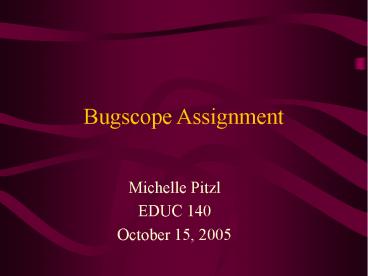Bugscope Assignment - PowerPoint PPT Presentation
Title:
Bugscope Assignment
Description:
... 'Bugs, Beetles, and Butterflies by Harriet Ziefert and ... It is a book that uses rhymed text and illustrations to introduce bugs, beetles and butterflies. ... – PowerPoint PPT presentation
Number of Views:133
Avg rating:3.0/5.0
Title: Bugscope Assignment
1
Bugscope Assignment
- Michelle Pitzl
- EDUC 140
- October 15, 2005
2
- Beetles are a part of the Coleoptera family which
comes from a word meaning sheath for their hind
wings. - Beetles have an incredible ability to adapt to
any environment which ensures us they will exist
much longer than human beings.
Picture of beetle seen through the naked eye.
3
- In addition to being associated with several
different plants, they can be found in land and
fresh-water habitats such as logs or under bark,
in fungi, in mud, in decaying plant and animal
matter, in water, in stored food, in bird and
mammal nests, and in termite nests. - Adult beetles range in size from 0.01 to almost 8
inches in body length, but antennae of some are
much longer than their bodies. Beetles usually
have hard bodies, but sometimes they are leathery
or even have soft bodies.
4
- Most beetles are dark brown or black, but many
are red, blue, green, purple or a combination of
colors and can be smooth or hairy. - Beetles usually have two sets of wings, the hard
front wings and the soft hind wings for flying.
http//www.betterpestcontrol.com/2103_1.jpg
5
- Beetles feed as scavengers on dead plants and
animals. Other species feed on fungi or mold, and
a few are parasitic on other insects or
vertebrate animals. - Did you know there are more species of beetles on
Earth than there are plants?!
Beetles leg magnified at 2560 where you are
capable of seeing the beetles setae.
http//bugscope.itg.uiuc.edu/members/2005-029/
6
Helpful Websites
- Amazing Insects website
- http//www.ivyhall.district96.k12.il.us/4th/kkhp/1
insects/beetles.html - Wonderful World of Insects website
- http//www.earthlife.net/insects/six.html
7
National Science Education Standards
- Content Standard C
- Grades K-4
- Organisms and their environments
- All animals depend on plants. Some animals eat
plants for food. Other animals eat animals that
eat the plants.
http//tolweb.org/tree/ToLimages/beetleflying.gif
8
Using Technologies
- Teachers can use technologies such as microscopes
and ESEMs in order to further the learning of
their students. - Students can take the information they have been
given and use technology to put it into a power
point presentation as a means of applying what
they have learned. - In using the microscopes, teachers are able to
show their students that a bug is made up of so
many different things. They can show magnified
slides of certain insects and have children guess
what the insect is being displayed.
9
Three Literature Sources
- One recommended source is Beetles and Bugs by
A.J. Wood and Maurice Pledger. Offers a
touch-and-feel adventure for children ages 4-6. - A second recommended book is The Beetle Alphabet
Book by Jerry Pallotta and David Bierdrzycki. A
book that uses various letters of the alphabet to
introduce different beetles - The third recommended book is Bugs, Beetles, and
Butterflies by Harriet Ziefert and Lisa Flather.
It is a book that uses rhymed text and
illustrations to introduce bugs, beetles and
butterflies.
http//browse.barnesandnoble.com
10
Applying the Bugscope Activity
- The bugscope can be applied as a creative writing
activity where students look at a picture of a
magnified bug and guess what part or what type of
insect it may be. - Another activity used from the bugscopes to
enhance learning is offering an opportunity like
we had to chat online. That way students can ask
questions and get the answers they are looking
for from professionals.
http//www.cemes.fr/Services/Microscopie/2010.jpg































